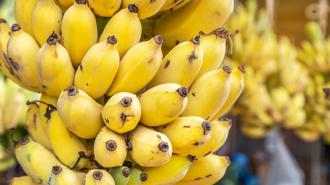Bananas are the world’s most consumed fruit (technically, second to tomatoes, but we all know they don’t really count). Chances are you have one sitting in your kitchen right now. And, if you bought a bunch like most people do, at least one of them is going bad already.
Bananas go bad so quickly that Americans throw away 5 billion bananas every year. But that could soon change.
In April of this year, the Philippines approved gene-edited bananas that ripen but do not turn brown. These bananas were engineered by UK-based biotech company Tropic Biosciences, using its proprietary gene manipulation technology. Here’s how they work.
Bananas go bad so quickly that Americans throw away 5 billion bananas every year. But that could soon change.
Silencing gene activity: Browning starts with ripening, a process mediated by the plant hormone ethylene. While all fruits make ethylene, bananas (as well as apples and peaches, among others) start producing large quantities of it as soon as ripening begins. This is essential for healthy ripening.
But ethylene also stimulates the production of an enzyme called polyphenol oxidase, which, in turn, has a positive feedback on ethylene synthesis — until you get a runaway process that quickly ends with brown, soft, rotting fruit.
Companies like Tropic Biosciences are now focusing on ways to limit the activity of this enzyme. Tropic did this with something called “gene editing-induced gene silencing” (GEiGS) technology. As the name suggests, it combines the power of gene editing and gene silencing.
For the editing, it relies on CRISPR technology to make precise edits to the banana DNA. For silencing, it uses RNA interference (RNAi) to reduce how active a gene is, preventing the production of its corresponding protein.
In Tropic’s non-browning bananas, a gene crucial for the production of polyphenol oxidase is silenced. Instead of editing the gene directly, the edits were made to non-protein coding regions of the genome, which just produce small RNAs. These RNA molecules are tweaked to make them interfere with, or silence, the transcription of the targeted gene, without modifying or removing it.
In April of this year, the Philippines approved gene-edited bananas that ripen but do not turn brown.
Bananas on the move: Like most food transported over long distances, bananas start going bad long before you buy them at a supermarket. Their tender exterior and squishiness make them highly prone to physical damage in transit. Even a minor cut accelerates the browning process by stimulating the production of polyphenol oxidase and ethylene.
As a result, a large fraction of exported bananas go to waste before reaching the customer. This contributes to greenhouse gas emissions both by wasting resources and gasses released directly by rotting biomass.
By slowing down the browning process, the company claims that its innovation will cut emissions across banana supply chains by 25%. An accurate picture of how long these gene-edited bananas resist browning compared to regular bananas in transit, and to what degree they reduce emissions in the real world, will only be known once they enter circulation.
Extinction threats: While browning is a challenge, Panama disease is an existential threat to bananas. The disease is caused by a fungus, Fusarium oxysporum, that can survive for decades in the soil, making it almost impossible to eradicate once it has taken hold.
In the 1950s, Panama disease devastated the Gros Michel banana, forcing planters to switch to Cavendish bananas, the most common variety grown today. Now, a particularly virulent strain of this fungus, Tropical race 4 (TR4), is spreading again across banana-cultivating regions around the world. Left unchecked, it will wreak havoc on the Cavendish banana.
Tropic is also editing the banana genome to tackle this disease. This gene-edited banana produces small RNAs that silence specific genes in the fungal genome, making the gene-edited bananas resilient to this pathogen. The company is also looking at pest resistance for other crops, focusing on the rice blast fungus.
Tropic also licences its technology to other agricultural companies to tackle other pathogens, and other companies are repurposing it to try to stop the spread of the avian influenza virus in chickens, protecting both poultry and humans.
Tropic Biosciences uses “gene editing-induced gene silencing” (GEiGS) technology to create bananas resistant to browning.
Non-GMO: There is a crucial difference between Tropic’s gene-edited crops and conventional genetically modified organisms (GMOs). Older genetically engineered crops sometimes inserted foreign DNA into their genomes, resulting in additional regulations and labeling rules.
Tropic’s approach, however, manipulates how the banana genome is expressed, without inserting any foreign DNA. This difference allows its crops to be marketed without being labeled as GMOs, making it attractive for more markets.
For a contrasting example, consider that the Philippines recently rolled back its approval of golden rice. This rice variety is genetically modified to boost vitamin A production, with the goal of reducing vitamin A deficiency, a cause of blindness in developing countries, but it has been at the center of a decades-long debate on GMOs and has struggled to gain approval.
Tropic’s non-browning bananas are the first gene-edited, non-GMO food to be approved in the Philippines. Will they suffer the fate of the golden rice, or herald a new wave of biotech food? It will be interesting to see if they face any hurdles to wider social acceptability.
If you’re excited about non-browning bananas, it might still take a couple of years before you can stock up on them, as the international banana trade is dominated by a handful of companies and at least one of them would have to start exporting it.
We’d love to hear from you! If you have a comment about this article or if you have a tip for a future Freethink story, please email us at tips@freethink.com.
